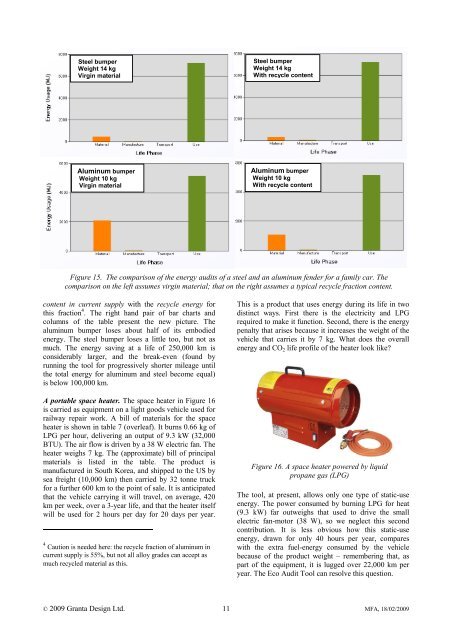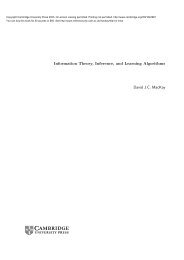The CES EduPack Eco Audit Tool ? A White Paper - MAELabs UCSD
The CES EduPack Eco Audit Tool ? A White Paper - MAELabs UCSD
The CES EduPack Eco Audit Tool ? A White Paper - MAELabs UCSD
Create successful ePaper yourself
Turn your PDF publications into a flip-book with our unique Google optimized e-Paper software.
Steel bumper<br />
Weight 14 kg<br />
Virgin material<br />
Aluminum bumper<br />
Weight 10 kg<br />
Virgin material<br />
content in current supply with the recycle energy for<br />
this fraction 4 . <strong>The</strong> right hand pair of bar charts and<br />
columns of the table present the new picture. <strong>The</strong><br />
aluminum bumper loses about half of its embodied<br />
energy. <strong>The</strong> steel bumper loses a little too, but not as<br />
much. <strong>The</strong> energy saving at a life of 250,000 km is<br />
considerably larger, and the break-even (found by<br />
running the tool for progressively shorter mileage until<br />
the total energy for aluminum and steel become equal)<br />
is below 100,000 km.<br />
A portable space heater. <strong>The</strong> space heater in Figure 16<br />
is carried as equipment on a light goods vehicle used for<br />
railway repair work. A bill of materials for the space<br />
heater is shown in table 7 (overleaf). It burns 0.66 kg of<br />
LPG per hour, delivering an output of 9.3 kW (32,000<br />
BTU). <strong>The</strong> air flow is driven by a 38 W electric fan. <strong>The</strong><br />
heater weighs 7 kg. <strong>The</strong> (approximate) bill of principal<br />
materials is listed in the table. <strong>The</strong> product is<br />
manufactured in South Korea, and shipped to the US by<br />
sea freight (10,000 km) then carried by 32 tonne truck<br />
for a further 600 km to the point of sale. It is anticipated<br />
that the vehicle carrying it will travel, on average, 420<br />
km per week, over a 3-year life, and that the heater itself<br />
will be used for 2 hours per day for 20 days per year.<br />
4 Caution is needed here: the recycle fraction of aluminum in<br />
current supply is 55%, but not all alloy grades can accept as<br />
much recycled material as this.<br />
Steel bumper<br />
Weight 14 kg<br />
With recycle content<br />
Aluminum bumper<br />
Weight 10 kg<br />
With recycle content<br />
Figure 15. <strong>The</strong> comparison of the energy audits of a steel and an aluminum fender for a family car. <strong>The</strong><br />
comparison on the left assumes virgin material; that on the right assumes a typical recycle fraction content.<br />
This is a product that uses energy during its life in two<br />
distinct ways. First there is the electricity and LPG<br />
required to make it function. Second, there is the energy<br />
penalty that arises because it increases the weight of the<br />
vehicle that carries it by 7 kg. What does the overall<br />
energy and CO2 life profile of the heater look like?<br />
Figure 16. A space heater powered by liquid<br />
propane gas (LPG)<br />
<strong>The</strong> tool, at present, allows only one type of static-use<br />
energy. <strong>The</strong> power consumed by burning LPG for heat<br />
(9.3 kW) far outweighs that used to drive the small<br />
electric fan-motor (38 W), so we neglect this second<br />
contribution. It is less obvious how this static-use<br />
energy, drawn for only 40 hours per year, compares<br />
with the extra fuel-energy consumed by the vehicle<br />
because of the product weight – remembering that, as<br />
part of the equipment, it is lugged over 22,000 km per<br />
year. <strong>The</strong> <strong>Eco</strong> <strong>Audit</strong> <strong>Tool</strong> can resolve this question.<br />
© 2009 Granta Design Ltd. 11 MFA, 18/02/2009
















